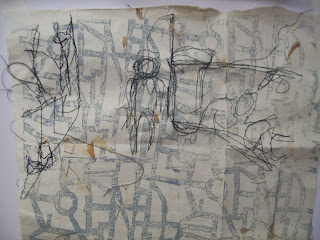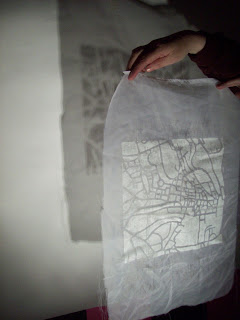I've recently learnt how to felt and with my first attempt I tried to make blue roads with thick pieces of felt. This didn't give me the effect I was hoping as it didn't look greatly like roads but at the edges of the blue felt were little strands coming off gave me the idea to finer strands. I tried felting pieces of map into my own and I even attempted sewing into felt pieces that I made.
After this I was introduced to a piece by Jeanette Appleton. In the exhibition 'Through The Surface' Jeanette Appleton is paired with Japanese textile artist, Naoko Yoshimoto for their similar concerns with the notion of memory and the transformation of substances from one state to another. Appleton produced a 45 meter length of needle felt for her exhibition piece showing along the length of the felted fabric the journey overtaken in this project and felting in pieces like cloths tags, water bottle labels, drawings and other things that she picked up on her journey with Yoshimoto.
I like how she created a long piece to demonstraight a journey stretched along a piece of fabric and will be something I'll consider for continuing on.
Through The Surface: Jeanette Appleton & Naoko Yoshimoto
Friday, 21 January 2011
Wednesday, 12 January 2011
3D Maps
While looking at most areas of how i can use and represent maps I thought I should also branch out into 3D work.
I started by using clay to carve into with a pattern like roads from a map. I built up walls around it and filled it with plaster. When the plaster had set I scrapped off the clay from the plaster to find this. This technique of carving into the clay makes it look rather rough and jaggedy, that I wasn't quite fond of.
I tried something similar with this one but instead of carving into it that made rough edges I rolled a paper template into the clay, creating smoother lines.
Then moved on to looking at metal work, using a template and a coping saw with a rather thin blade, I was able to cut out this metal section of a map out of aluminium. After cutting it out I needed to sand it for smooth edges.
I then used my metal map section to imprint into clay. I then added coloured resin into the sunken roads but unfortunatly using different colours at the same time the different colours began to blend. Once that had set I then added another layer of clear resin on top.
I've used resin again to trap two layers of cut out maps inside. This worked pretty well and if I had any more resin I would have added more layers of cut out map. This links back to me layering cut out maps for shadows. Also it reminds me of how some cities are built on top of older cities, I think I recall being told that the city Edinburgh had it's city built on top giving different layers of builds that I found quite interesting when I visited.
Thursday, 6 January 2011
Translating My Walking Drawings
Continuing with my walking drawings I wanted to develop them further. I've tried different ways in which I can translate my images that are monoprinting and drawing using a sewing machine.
This worked pretty well and I tried it over different backgrounds, like on screen printed pieces, repetitive lyno prints and other map backgrounds.
Concentrating closely to the walking drawings I used a sewing machine to copy the scribbly lines. I really liked using a sewing machine to draw.
This worked pretty well and I tried it over different backgrounds, like on screen printed pieces, repetitive lyno prints and other map backgrounds.
Concentrating closely to the walking drawings I used a sewing machine to copy the scribbly lines. I really liked using a sewing machine to draw.
Recording My Journey
While I visiting Oxford and London I did a lot of travelling around to do my walking drawing, I took this oppertunity to record where I walked around the cities.
This is the start of the next step in my work as I'll branch off to journeys and how I can present them.
Strip Collages: Sandra Meech
When making a quilt piece I came across Sandra Meech's work, she creates quilts using different fabrics collaged together in stips and patches.
I took this idea to make my own stip pieces by ripping long strips of paper and maps, with cotton scrim and lace ribbon I used a sewing machine to sew all the pieces together side by side over lapping.
I thought this looked too white so on my second one I tea stain the entire thing afterwards.
This looked too brown and the pictures wasn't working very well so I tried tea staining only the white photocopies of my walking drawings before ripping them into strips.
Walking Drawing: Mary Clare Foa
I've came across Mary Clare Foa who does alot of movement drawing, where she'd draw while walking and a series of rapidly drawn views from trains that she’d record hastily in a few lines. I found this to link very well to my project, and something i could begin to experimnt with.
When I started this off I began by stoping and drawing sepreate pictures on a route.
Then I tried walking and drawing at the same time when I was visiting Oxford and London.
I then tried drawing on buses, where I started by drawing seperate pictures of each stop.
Then each stop on one page.
After that I drew everything on one page.
And finally I started drawing everything on one page and switching to a new page before the first page got too full of lines and scribble.
When I started this off I began by stoping and drawing sepreate pictures on a route.
I then tried drawing on buses, where I started by drawing seperate pictures of each stop.
Then each stop on one page.
After that I drew everything on one page.
And finally I started drawing everything on one page and switching to a new page before the first page got too full of lines and scribble.
Wednesday, 5 January 2011
Shadow Catchers Exhibition
I went to London to visit the 'Shadow Catchers' exhibition in the V&A Gallery. This Exhibition Presents the work from 5 international contempory artists that without a camera create images on photographic paper by casting shadows and manipulating light, or by chemically treating the surface of the paper. Images made with a camera imply a documentary role. In contrast, camera-less photographs show what has never really existed.
The one artist I was most interested in while visiting was Floris Neusüss that makes photograms mainly of the human image. I like how his work captures brief and glimpsing moments using light sensitive paper.
This piece to me always seemed quite ghostly, but I still really like it because it obviously shows how someone was there but no longer.
This was my favorite of which I seen of Neusüss' work. It doesn't look like much from a first view but after reading it's discription of how he made it was what I was most amazed by. What he did to create this was placing photographic paper in a garden at night during a thunderstorm, and letting lightning expose the paper.
Shadow Catchers
Floris Neusüss Shadow Catchers Video
This piece to me always seemed quite ghostly, but I still really like it because it obviously shows how someone was there but no longer.
This was my favorite of which I seen of Neusüss' work. It doesn't look like much from a first view but after reading it's discription of how he made it was what I was most amazed by. What he did to create this was placing photographic paper in a garden at night during a thunderstorm, and letting lightning expose the paper.
Shadow Catchers
Floris Neusüss Shadow Catchers Video
Monday, 3 January 2011
Monika Jarg and Transparent House
http://www.tekstiilruumis.ee/indexeng.html
While I'm looking at floors I've also found this, this beautiful new concrete flooring from san francisco’s trasnparent house team. They’ve created a way to add these soft floral patterns to polished concrete flooring either doing the pouring or after the concrete has set. I think it's absolutely beautiful how they've added detail to the flooring without taking away from the simplicity of the style, also how something so eatheral as nature is forever inprinted in an industrial styled concrete floor. Ok floorboads are quite uncommon in mondern houses, so this will be what I want instead.
Printing & Sewing with Maps
From cut out maps I began to look at printing through cut out maps and after collage I thought this could be a good point to persist with looking at various types of backgrounds. I've tried using cellulose thinner on fabrics and multiple ways I can use a variety of materials together. I also tested printing on to translucent fabric, that work pretty well and i'm intending on using these again. I tried out two types of patterns to print; the first is of a cut out map and the other of a pattern that is related to maps like a pirate map.
I've sewn into a couple of my printed pieces and I liked how I sewn along the roads of one that it gave me the idea to make a quilt doing the same.
I loved how my quilted piece turned out I wanted to do more with this idea that I tried sewing into maps. After sewing along the roads didn't make much of an effect on the map I tried sewing along the contour lines of a map. After a whole day at the sewing machine I was amazed how beautiful the pattern created was. I'd like to copy this further but I all them lines are too complicated to translate without having the map with the line work into.
I've sewn into a couple of my printed pieces and I liked how I sewn along the roads of one that it gave me the idea to make a quilt doing the same.
I loved how my quilted piece turned out I wanted to do more with this idea that I tried sewing into maps. After sewing along the roads didn't make much of an effect on the map I tried sewing along the contour lines of a map. After a whole day at the sewing machine I was amazed how beautiful the pattern created was. I'd like to copy this further but I all them lines are too complicated to translate without having the map with the line work into.
Collages with Maps: Peter Clark & Jerry Gretzinger
Dog Collage - Peter Clark
I looked briefly at college by creating one containing pieces of map like peter clark, after doing that it seemed obvious to add more to the piece by linking all the roads from each slice of map together to create my own personal made up map.
I looked briefly at college by creating one containing pieces of map like peter clark, after doing that it seemed obvious to add more to the piece by linking all the roads from each slice of map together to create my own personal made up map.
'The Gretzinger Map' - Jerry Gretzinger
I like how this is an ongoing project and that it's all made up. It reminds me of when I was younger when I'd create my own pictures of fictional places and playing platform games on the playstation 2 like grand theft auto. it's obvious he's put alot of imagination and research into making these maps incorporate towns and cities with museums, government buildings, churches, parks, railroad stations and airports.
Subscribe to:
Comments (Atom)















































